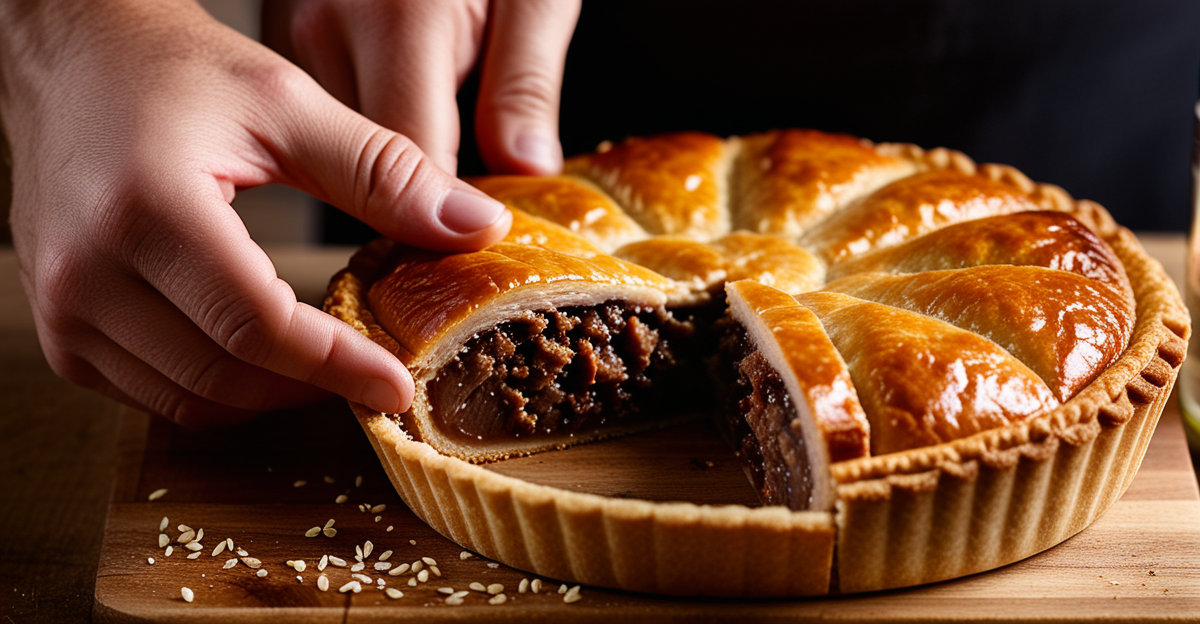Essential Ingredients for a Traditional Savory Pork Pie
When crafting a traditional pork pie recipe, selecting the right pork pie ingredients is fundamental to achieving authentic flavor and texture. The core elements include carefully chosen meat cuts, a robust seasoning blend, and quality pastry components, all combining to create the quintessential homemade pork pie essentials.
For the meat, the best results come from using a mix of lean and fatty cuts, typically pork shoulder or pork leg, which provide the perfect balance of juiciness and binding fat. These cuts ensure the filling remains succulent while holding together during baking. Seasoning commonly involves a combination of salt, pepper, and nutmeg to evoke the classic savory profile. Some recipes also recommend incorporating finely chopped pork fatback to enhance moisture and richness without overpowering the meat’s natural taste.
Additional reading : What are the key steps to a classic shepherd’s pie?
The pastry, usually a hot water crust style, plays a vital role in encasing the filling tightly and offering structural support. High-quality plain flour and fresh butter or lard are the cornerstones of this pastry, contributing to its distinctive crispness and durability.
Sourcing ingredients from trusted suppliers guarantees freshness and authenticity. Opting for pork raised without excessive additives results in better flavor and texture, which are critical in replicating a time-honored traditional pork pie recipe. By focusing on these homemade pork pie essentials, you lay the foundation for a pie that honors heritage while delighting the palate.
Also to discover : How can you elevate your afternoon tea with unique sandwich fillings?
Preparing the Pork Pie Filling
Understanding the detailed steps to create a perfect pork filling
The pork pie filling is the heart of a traditional pork pie recipe, requiring careful preparation to balance texture and flavor. Begin by finely chopping a combination of lean and fatty pork cuts. This ensures the filling holds together well after cooking without becoming dry or overly greasy. The best pork pie filling preparation starts with seasoning the meat thoughtfully. A traditional blend involves salt, black pepper, and a touch of nutmeg, which highlights the pork’s natural flavors while giving a classic savory note.
Adding finely minced pork fatback or suet enhances moisture and richness, preventing the filling from drying out during baking. For depth, some recipes also incorporate a small amount of finely chopped onion or herbs, but these are optional depending on desired taste.
Marinating the seasoned pork pie filling before stuffing can improve flavor infusion. Refrigerate the mixture for at least a few hours, or overnight if possible, to allow the spices to meld fully. Chilling the filling also firms the meat slightly, making it easier to handle and shape once placed into the pastry shell.
To summarize, pork filling preparation involves:
- Using suitable pork cuts, balancing lean and fat
- Seasoning with traditional herbs and spices
- Optionally adding fat or aromatics for moisture and depth
- Marinating and chilling to improve consistency and flavor
Mastering the pork pie filling steps guarantees a well-flavored, juicy filling — a critical homemade pork pie essential.
Making Hot Water Crust Pastry
Creating an authentic hot water crust pastry is vital when learning how to make pork pie pastry, as it provides the sturdy yet tender casing that holds the filling perfectly. This pastry differs from standard recipes by using hot water to melt fats before mixing, producing a dough flexible enough to shape but strong enough to maintain structure through baking.
To start, bring water, along with lard or butter, to a near-boil temperature until the fat fully melts. Quickly pour this hot mixture over sifted plain flour. Stir vigorously while the mixture is still warm—this is key to combining the flour and fat uniformly. Achieving the right consistency means the dough should be pliable but not sticky, which allows easy handling and shaping.
After mixing, proper kneading is essential. Knead the dough on a lightly floured surface until smooth; this develops its elasticity, critical for shaping into traditional pie forms. For beginners, aiming for a dough that holds its shape without tearing or sagging during assembly is paramount.
Rolling the pastry to an even thickness, generally around 3-5mm, ensures consistent baking and a balanced crust-to-filling ratio. This precise thickness prevents sogginess from steam while maintaining the characteristic crispness. When lining pie moulds or tin bases, handling the dough gently avoids cracks but ensures snug coverage.
Mastering hot water crust pastry transforms a basic casing into a resilient vessel that complements the rich pork filling of any traditional pork pie recipe. The pastry’s texture and durability are fundamental homemade pork pie essentials for both taste and presentation.
Assembling the Pork Pie
Careful assembling pork pie is essential to achieve the iconic structure and appearance characteristic of a traditional pork pie recipe. Start by lining your pie mould with the prepared hot water crust pastry, pressing gently to avoid tears while ensuring complete coverage of the base and sides. The pastry must be smooth and even, as this foundation holds the filling securely.
Next, add the pork pie filling by spooning the chilled, well-mixed filling evenly into the pastry case. Press the meat lightly to remove air pockets and create solid layers without compressing the mixture too much, which could affect texture. The key in layering pork pies lies in building a consistent, compact filling that retains moisture yet bakes uniformly.
After filling, place the pastry lid over the top, aligning edges carefully. Trim any excess dough and press the edges together firmly to seal. Some recipes recommend crimping the seal or using a light egg wash to ensure the pie remains watertight during baking. Proper sealing prevents juices from leaking and keeps the pie’s shape intact.
Finishing touches might include decorating the pastry top with small shapes or a central hole to allow steam to escape, which aids in even cooking and prevents sogginess. Avoid common assembly mistakes like insufficient sealing or uneven pastry thickness, as these can compromise the pie’s integrity and presentation.
Mastering these steps in constructing traditional pork pies guarantees a pie that bakes evenly, maintains a crisp crust, and contains a juicy, flavorful filling — essential elements of any homemade pork pie essentials list.
Baking and Cooling the Pork Pie
Achieving the perfect baking pork pie outcome depends heavily on precise oven temperature control and timing. Typically, the pie bakes at a moderate heat—around 180°C (350°F)—for approximately 1 to 1.5 hours. This duration ensures the hot water crust pastry crisps up while the filling cooks thoroughly without drying out. Starting with a preheated oven is crucial; placing the pie in a cold oven can cause uneven cooking and soggy crust.
Monitoring doneness involves checking both the crust’s color and firmness. A golden brown sheen indicates the pastry is well-baked. Additionally, tapping the pie’s base can reveal if the crust is cooked through; a hollow sound suggests adequate crispness and moisture evaporation inside. Overbaking risks toughening the pastry and drying the delicate pork filling, so timing should be carefully observed.
Once removed from the oven, proper cooling pork pie methods are essential to preserve structural integrity. Allow the pie to cool in its tin on a wire rack, promoting even airflow underneath that prevents condensation buildup. Cooling at room temperature gradually sets the filling and gelatin layers, which solidify the pie’s core and prevent juice leakage during slicing.
Some traditional recipes recommend chilling the pie further in a refrigerator after initial cooling. This step firms the flavors and texture, making for easier slicing and enhanced taste experience. However, avoid covering the pie immediately to prevent trapping moisture that softens the crust.
Incorporating these best practices for pork pie oven tips and cooling guarantees a classic, resilient crust and a moist, flavorful filling, hallmarks of a well-executed traditional pork pie recipe.
Jelly Preparation and Addition
Adding pork pie jelly is a traditional step that enhances both the flavor and longevity of a traditional pork pie recipe. Making the jelly begins by creating a clear, gelatin-rich stock. This typically involves simmering pork bones, trotters, or skin to extract natural gelatine, often combined with aromatic vegetables for subtle seasoning. The resulting stock is then strained carefully to produce a clean liquid suitable for setting.
Once cooled, the jelly is gently reheated to a pourable consistency without boiling, which could break down the gelatine properties. After the pie has finished baking and cooled enough to firm up, a small hole is made—usually through a vent on the lid or base—to pour the warm jelly inside the hollow space around the cooked filling. This step fills gaps and traps moisture, preventing the pork pie from drying out.
Adding gelatine for meat pies like pork pies not only contributes to preservation by sealing the contents from air exposure but also intensifies the overall taste experience. The jelly slowly sets inside the pie as it cools fully, creating an appealing, shiny glaze and a smooth texture contrast with the robust pork filling and crisp hot water crust pastry.
In summary, mastering pork pie jelly preparation and proper adding jelly to pork pie techniques are vital homemade pork pie essentials that uphold tradition while enhancing moisture retention and flavor depth.
Essential Ingredients for a Traditional Savory Pork Pie
Selecting the right pork pie ingredients is crucial to crafting a truly authentic traditional pork pie recipe. Central to this is choosing meat cuts that balance lean and fat content for ideal flavor and texture. The recommended cuts are typically pork shoulder or leg, prized because they provide both succulence and binding fat needed to keep the filling juicy yet cohesive during baking. Incorporating finely chopped pork fatback further enhances moisture without overpowering the meat’s natural taste, a key component among homemade pork pie essentials.
Seasoning forms a foundation of savory flavor in these pies. A classic blend includes salt, black pepper, and nutmeg, which evokes the traditional taste profile expected in a genuine pork pie. These spices not only bring warmth and depth but also highlight the pork’s natural essence without masking it. Some recipes may extend seasoning with subtle additions like herbs or onion, but these remain secondary to the core spice mix.
For the pastry, the quality of ingredients directly affects the pie’s texture and durability. The use of plain flour combined with fresh butter or lard creates the hallmark crispness and structure of a true hot water crust pastry. This pastry style is essential for maintaining the pie’s shape and supporting the heavy filling, making it one of the indispensable homemade pork pie essentials in the baking process.
Sourcing fresh, high-quality ingredients is another fundamental step. Utilizing meat from trusted suppliers who provide pork free from excessive additives ensures a superior flavor and texture base. This attention to sourcing is integral to replicating a classic traditional pork pie recipe. Ultimately, by focusing on these carefully selected and combined pork pie ingredients, you lay the groundwork for crafting a savory pie that honors tradition while delivering satisfying taste and texture.




